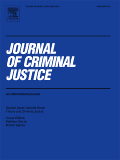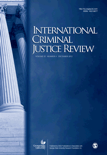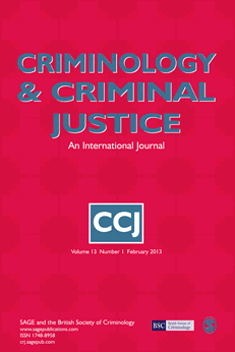
JOURNAL OF CRIMINAL JUSTICE
Scope & Guideline
Innovating solutions for contemporary justice challenges.
Introduction
Aims and Scopes
- Crime Prevention and Control:
Research focusing on effective strategies for crime prevention, including community policing, situational crime prevention, and intervention programs aimed at reducing recidivism. - Behavioral and Psychological Aspects of Crime:
Exploration of the psychological and behavioral factors contributing to criminal activity, including studies on mental health, personality traits, and the impact of adverse childhood experiences. - Policy Analysis and Reform:
Critical examination of criminal justice policies, their implementation, and the effects of reforms on crime rates and justice system efficacy. - Technology and Crime:
Investigations into the role of technology in crime detection, prevention, and law enforcement practices, including the use of body-worn cameras and machine learning in policing. - Social Justice and Inequality:
Analysis of the intersection of crime with social justice issues, including racial and ethnic disparities in the criminal justice system and the impact of socioeconomic factors on crime. - Criminal Justice System Dynamics:
Studies examining the interactions and relationships within the criminal justice system, including the roles of law enforcement, the judiciary, and correctional institutions.
Trending and Emerging
- Impact of COVID-19 on Crime and Policing:
A surge in research examining how the COVID-19 pandemic has influenced crime rates, police practices, and community responses, highlighting the need for adaptive strategies in law enforcement. - Mental Health and Criminal Justice:
An increasing focus on the intersection of mental health issues and criminal justice, exploring how mental health conditions affect offending behavior and justice system interactions. - Use of Technology in Policing:
Research into the application of advanced technologies, such as machine learning and data analytics, in crime prediction, policing strategies, and enhancing accountability within law enforcement. - Community and Restorative Justice Approaches:
A trend towards exploring community-based interventions and restorative justice practices that aim to repair harm and reduce recidivism through community involvement and support. - Racial and Ethnic Disparities in Criminal Justice:
Growing emphasis on understanding and addressing racial and ethnic disparities within the criminal justice system, focusing on systemic biases and their implications for policy reform. - Environmental Influences on Crime:
Emerging studies examining the role of environmental factors, such as neighborhood characteristics and urban design, in influencing crime patterns and community safety.
Declining or Waning
- Traditional Crime Categories:
Research focusing on traditional crime categories such as burglary and theft has seen a decline, possibly due to the increasing focus on more complex and systemic issues like drug-related crimes and violent offenses. - Historical Criminology:
While still relevant, studies specifically centered on historical perspectives of crime are less frequent, indicating a possible waning interest in examining crime through a strictly historical lens. - Focus on Individual Offenders:
There has been a noticeable shift away from studies that exclusively focus on individual offenders and their characteristics towards broader systemic analyses that include social and environmental factors. - Simplistic Models of Crime:
Research employing overly simplistic models of crime causation is declining, as the field increasingly recognizes the need for more nuanced, multifactorial approaches to understanding criminal behavior. - General Deterrence Theory:
The traditional focus on deterrence theory in relation to punishment and crime rates appears to be diminishing in favor of more comprehensive analyses that consider rehabilitation and restorative justice.
Similar Journals

Journal of Criminal Psychology
Unraveling the complexities of criminal behavior with rigorous analysis.Journal of Criminal Psychology, an esteemed publication by EMERALD GROUP PUBLISHING LTD, serves as a pivotal resource in the interdisciplinary study of criminal behavior through the lenses of psychology and law. Since its inception in 2011, this journal has significantly contributed to the understanding of psychological principles as they apply to crime, law enforcement, and social justice, making it a vital source for both researchers and practitioners. With a commendable ranking of Q1 in Law and Q3 in Applied and Social Psychology for 2023, the journal guarantees high-quality research findings that can influence policy and practice across these domains. Although it does not offer open access, its rigorous peer-review process ensures that every published article adheres to the highest academic standards. The Journal of Criminal Psychology not only fosters academic discourse but also drives innovation in criminal justice practices, making it essential reading for anyone dedicated to the enhancement of ethical standards in legislation and law enforcement.

International Criminal Justice Review
Elevating discourse on global justice issues.International Criminal Justice Review is a premier journal in the field of law, published by SAGE Publications Inc, renowned for its commitment to advancing the understanding of criminal justice issues on a global scale. With an ISSN of 1057-5677, this journal spans a rich history from its inception in 1991 to its ongoing contributions into 2024, supporting a diverse array of research that addresses both theoretical and practical concerns in international criminal law. The journal holds a prestigious Q1 ranking in the Law category for 2023, reflecting its influence and relevance, as evidenced by its impressive Scopus rank of #68 out of 1025 in the Social Sciences Law field, placing it in the 93rd percentile. Though not an open-access journal, it provides vital access options for institutions and individuals alike. International Criminal Justice Review serves as a critical resource for researchers, practitioners, and students dedicated to exploring the complexities of international criminal justice systems, offering a platform for innovative scholarship that informs policy and practice worldwide.

Asian Journal of Criminology
Innovating Insights into Crime and Society in AsiaAsian Journal of Criminology, published by SPRINGER, stands as a pivotal platform for scholarly communication within the field of criminology, boasting a notable impact factor and achieving a distinguished Q1 ranking in Law for 2023. Located in the Netherlands, this journal addresses the complexities of crime and justice in Asian contexts, fostering interdisciplinary discourse between researchers, practitioners, and policymakers. Since its inception in 2006 and continuing through to 2024, the journal has published a range of high-quality articles that explore theoretical frameworks, empirical research, and practical applications in criminology. Although the journal is not open access, it remains accessible through academic libraries and institutions, ensuring its wide reach among scholars and students. With a Scopus ranking of 143 out of 1025 in the field of Social Sciences Law, placing it in the 86th percentile, the Asian Journal of Criminology is essential for anyone looking to stay at the forefront of criminological research and its application in diverse societal contexts.

JOURNAL OF QUANTITATIVE CRIMINOLOGY
Exploring the Intersection of Law and ForensicsJOURNAL OF QUANTITATIVE CRIMINOLOGY, published by Springer/Plenum Publishers, serves as a premier outlet for cutting-edge research in the fields of law and forensic medicine. With an impressive impact factor and ranked in the top quartile (Q1) of both Law and Pathology and Forensic Medicine categories in 2023, this journal excels in providing empirical analyses and quantitative assessments that address critical issues in criminological research. Since its inception in 1985, the journal has maintained a reputation for excellence, evidenced by its high standing in Scopus rankings—21st out of 1025 in Social Sciences (Law) and 23rd out of 208 in Medicine (Pathology and Forensic Medicine). Although currently not an open access publication, it offers several subscription-based access options to reach a wide array of academics and professionals dedicated to the advancement of criminological and forensic inquiries. Researchers, professionals, and students will find the JOURNAL OF QUANTITATIVE CRIMINOLOGY an invaluable resource, as it fosters interdisciplinary collaboration and methodological rigor in understanding crime and criminal behavior.

Revista Criminalidad
Connecting Theory and Practice in Criminal StudiesRevista Criminalidad, published by POLICIA NAC COLOMBIA, is a distinguished academic journal that has been open access since 1958, making critical research in the field of criminology readily available to the global scholarly community. Based in Colombia, this journal serves as a prominent platform for the dissemination of high-quality research on crime, law, and social sciences. Notably categorized in various quartiles for 2023, including Q2 in Arts and Humanities (miscellaneous) and Q3 in Law, it holds respectable rankings in the Scopus database, reflecting its significance and contribution to both academic and practical discourse. The journal invites researchers, professionals, and students to explore its comprehensive scope, spanning vital themes relevant to criminology and public safety, making it an essential resource for those invested in the interplay between society, law, and criminal behavior. For up-to-date research and insights, the journal is accessible at the CENTRO INVESTIGACIONES CRIMINOLOGICAS DIJIN, AVE EL DORADO 75-25, BOGOTA.

Criminology & Criminal Justice
Shaping the Future of Criminology and Criminal JusticeCriminology & Criminal Justice is a leading academic journal published by SAGE Publications Ltd that serves as an essential resource for scholars, practitioners, and students in the field of criminology and legal studies. With its ISSN 1748-8958 and E-ISSN 1748-8966, this journal has established itself as a crucial platform for innovative research, analysis, and discourse, consistently maintaining a prestigious Q1 ranking in Law. Spanning a diverse range of topics within criminology and criminal justice, it promotes interdisciplinary perspectives that reflect current trends and challenges within the domain. With a notable 93rd percentile ranking in Scopus, the journal ensures that its publications meet rigorous academic standards, fostering the advancement of knowledge and practice in the field. Based in the United Kingdom and catering to a global audience, this journal enhances scholarly communication and collaboration, making it an indispensable tool for those dedicated to unraveling the complexities of crime and justice.

Russian Journal of Criminology
Bridging cultural perspectives in the study of criminology.Russian Journal of Criminology (ISSN: 2500-4255, E-ISSN: 2500-1442) is an esteemed academic publication hosted by Baikal State University, dedicated to advancing the field of criminology. As a pivotal resource within the domains of law and social sciences, this journal offers a platform for scholars to disseminate innovative research, critical analyses, and comprehensive studies relevant to contemporary criminological issues. Although coverage has been discontinued in Scopus from 2020, the journal continues to provide valuable insights essential for professionals and researchers alike, with a focus on sociological and political perspectives on crime and justice systems. With its unique Russian context, the journal encourages a diverse array of submissions, facilitating a cross-cultural dialogue on criminology that contributes to global scholarship. Despite its current ranking of 478 out of 685 in law and 908 out of 1243 in sociology and political science, the Russian Journal of Criminology remains a vital resource for those seeking to explore the complexities of criminological phenomena and to further the academic discourse in this critical area of study.

Journal of Experimental Criminology
Transforming Criminology Through Experimental ResearchThe Journal of Experimental Criminology, published by Springer, stands as a beacon of innovation within the realm of criminology and legal studies. With an ISSN of 1573-3750 and E-ISSN 1572-8315, this esteemed journal, based in the Netherlands, explores groundbreaking research and experimental approaches to understanding criminal behavior and justice systems. It proudly resides in the elite Q1 quartile of the law category for 2023, ranking an impressive #37 out of 1025 in Scopus within the Social Sciences _ Law domains, placing it in the 96th percentile among its peers. The journal's objectives are aimed at disseminating high-quality empirical research that informs policy and practice, making it an essential resource for scholars, practitioners, and students who strive to enhance the efficacy of crime prevention and criminal justice interventions. With coverage spanning from 2005 to 2024, the Journal of Experimental Criminology invites contributors from diverse backgrounds to engage in the interdisciplinary dialogue that shapes the future of criminological research.

Women & Criminal Justice
Catalyzing Change Through Scholarly InsightWomen & Criminal Justice, published by Routledge Journals, Taylor & Francis Ltd, stands as a prominent platform for scholarly discourse in the intertwined realms of gender studies and legal research. Since its inception in 1989, this journal has been pivotal in addressing the unique challenges and perspectives of women within the criminal justice system, making substantial contributions to the field. With a commendable impact factor reflected in its Q1 ranking in Law and Q2 ranking in Gender Studies, it offers both researchers and practitioners rigorous and insightful analyses. The journal covers a wide spectrum of topics, aligning contemporary issues with legal frameworks, while advocating for a nuanced understanding of gender-related injustices. Though it operates under a traditional access model, its invaluable insights foster essential discussions among academics, policymakers, and social advocates. By engaging with themes of societal crime, victimization, and justice reform, Women & Criminal Justice continues to underscore the importance of integrating gender awareness into legal scholarship and practice, thereby enriching the broader academic community.

PSYCHOLOGY CRIME & LAW
Advancing Understanding at the Intersection of Psychology and LawPSYCHOLOGY CRIME & LAW, published by Routledge Journals, Taylor & Francis Ltd, is a premier academic journal dedicated to the intersection of psychology, criminology, and the law. With an ISSN of 1068-316X and an E-ISSN of 1477-2744, this journal provides a critical platform for the dissemination of cutting-edge research and innovative methodologies in the fields of psychology, forensic medicine, and legal studies. Spanning over three decades (1994 to 2024), it holds impressive Scopus rankings, placing it in Q1 and Q2 quartiles for its contributions to law and forensic medicine, highlighting its standing within the academic community. PSYCHOLOGY CRIME & LAW is particularly noted for addressing contemporary issues at the crossroads of human behavior and legal standards, making it essential reading for scholars, practitioners, and students alike. While the journal is not open access, it offers valuable insights into a variety of topics, from criminal psychology to the implications of mental health in legal contexts, ensuring that it remains an influential resource for those engaged in research and professional practice.